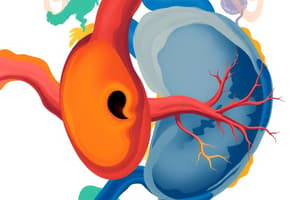Podcast
Questions and Answers
What structure needs to be cut near the abdominal wall to reflect the thoracoabdominal wall?
What structure needs to be cut near the abdominal wall to reflect the thoracoabdominal wall?
- Lesser omentum
- Round ligament of the liver (correct)
- Falciform ligament (correct)
- Falx cerebri
Which artery is the inferior epigastric artery a branch of?
Which artery is the inferior epigastric artery a branch of?
- Aorta
- External iliac artery (correct)
- Internal thoracic artery
- Femoral artery
Which of the following is NOT a feature of the peritoneal cavity?
Which of the following is NOT a feature of the peritoneal cavity?
- Visceral peritoneum
- Falciform ligament (correct)
- Lesser omentum
- Greater omentum
What is the function of the pyloric sphincter?
What is the function of the pyloric sphincter?
Where can the spleen be found during an abdominal examination?
Where can the spleen be found during an abdominal examination?
Which part of the stomach is closest to the esophagus?
Which part of the stomach is closest to the esophagus?
What does the portal triad consist of?
What does the portal triad consist of?
Which curvature of the stomach is oriented towards the liver?
Which curvature of the stomach is oriented towards the liver?
What should be done after cleaning the bile duct proximally?
What should be done after cleaning the bile duct proximally?
Which arteries are revealed after cleaning the proper hepatic artery proximally?
Which arteries are revealed after cleaning the proper hepatic artery proximally?
What follows the identification of the splenic artery during dissection?
What follows the identification of the splenic artery during dissection?
What is the purpose of pushing the jejunum and ileum to the right during dissection?
What is the purpose of pushing the jejunum and ileum to the right during dissection?
Where should one palpate to find the superior mesenteric artery and vein?
Where should one palpate to find the superior mesenteric artery and vein?
During dissection, what should be cleaned to follow the superior mesenteric artery back to the aorta?
During dissection, what should be cleaned to follow the superior mesenteric artery back to the aorta?
What structure should be identified when examining the transverse colon?
What structure should be identified when examining the transverse colon?
What should happen to the greater omentum during dissection?
What should happen to the greater omentum during dissection?
Flashcards are hidden until you start studying
Study Notes
Abdominal Dissection Overview
- Reflect thoracic wall by making lateral cuts along ribs and the upper abdominal wall.
- Extend cuts towards anterior superior iliac spines (ASIS), avoiding damage to underlying organs.
- Reflect entire thoracoabdominal wall inferiorly to expose the abdominal cavity; cut falciform and round ligament of liver if needed.
Examining the Anterior Abdominal Wall
- Identify the arcuate line and transversalis fascia.
- Locate inferior epigastric artery, which arises from the external iliac artery and anastomoses with the superior epigastric artery.
Peritoneal Cavity and Abdominal Viscera
- Recognize components of the peritoneal cavity: parietal and visceral peritoneum, greater omentum, and lesser omentum.
- Identify major organs: liver, stomach, and gall bladder; may require retraction of liver’s inferior border.
Stomach Anatomy
- Locate the following features on the stomach:
- Greater curvature and lesser curvature
- Body, fundus, cardia, and pylorus
- Abdominal esophagus enters stomach at cardia.
- Find proximal duodenum distal to the pylorus, separated by the pyloric sphincter.
Liver Anatomy
- Identify structures of the liver:
- Right and left lobes
- Falciform ligament and ligamentum teres (round ligament of liver)
- Lesser omentum connects liver to lesser curvature of the stomach.
- Use closed-open technique to expose portal triad: bile duct, proper hepatic artery, and portal vein.
- Clean bile duct to identify cystic duct and hepatic duct, tracing to the duodenum.
- Clean proper hepatic artery to see branches: common hepatic artery, right gastric artery, and gastroduodenal artery.
- Trace splenic artery to the spleen, noting its relationship to the pancreas and the head’s position relative to descending duodenum.
Intestinal Structures
- Turn greater omentum over the stomach to view large and small intestines.
- Trace digestive tract from stomach through:
- Duodenum → jejunum → ileum → ileocecal junction → cecum → ascending colon → right colic flexure → transverse colon → left colic flexure → descending colon → sigmoid colon.
- Recognize haustra and teniae coli along the colon.
- Detach transverse colon from greater omentum, preserving attachment to stomach.
- Shift jejunum and ileum to the right; locate the mesentery.
- Palpate root of the mesentery for superior mesenteric artery and vein using the closed-open technique to reveal their courses to the aorta.
Studying That Suits You
Use AI to generate personalized quizzes and flashcards to suit your learning preferences.




